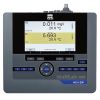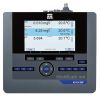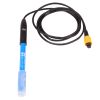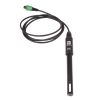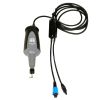YSI MultiLab 4010-1W Single Channel Benchtop Meter
The YSI MultiLab 4010-1W measures pH, ORP, conductivity or BOD accurately in the laboratory. The MultiLab 4010-1W has one channel to accommodate any of the probe choices.
Features
- Single channel input for pH, ORP, DO/BOD, or conductivity
- 500 data set storage in manual mode; 5,000 data sets in automatic logging mode
- Large, easy to read backlit graphic display
- Free ground shipping
- Expedited repair and warranty service
- Lifetime technical support
- More
Overview
The YSI MultiLab 4010-1W measures pH, ORP, conductivity or BOD accurately in the laboratory. The MultiLab 4010-1W has one channel to accommodate any of the probe choices.
Benefits
- One channel input for pH, ORP, DO/BOD, or conductivity
- 500 data sets in manual mode and 5,000 data sets in automatic logging mode
- Large, easy-to-read graphic display
- Intelligent, digital plug-and-play sensors
- GLP traceability (sensors store serial # and calibration data)
- USB connectivity to manage data
- 3-year warranty
IDS Intelligent Digital Sensors
The IDS sensors automatically store their unique serial number and calibration data. In addition, they also digitally process the measurement signal. The sensors can be moved from instrument to instrument and maintain their calibration data and transmit this information to the new instrument.
- Plug-and-play connectivity with each instrument
- IDS sensors store their own unique ID with serial number and calibration data
- Digital sensor recognition, processing and data transfer
- Includes self-stirring BOD, pH, ORP and conductivity sensors
- BOD probe uses optical dissolved oxygen technology and includes a guarded sensor tip
Parameters: pH, ORP (mV), DO %, DO mg/L (BOD probe), Partial pressure, Conductivity, Resistivity, Salinity, TDS, Temperature
Measurement Channels: 1
Data Storage: 500 data sets in manual mode and 5,000 data sets in automatic mode
Interface/PC Connectivity: Mini USB; USB-A
Display: Graphic
Power Supply: Universal power supply
Temperature Compensation: Yes; except ORP
Calibration Points: DO and Conductivity = 1; pH = 1 to 5
Calibration Storage: 10 maximun
Calibration Timer: 1 to 999 days
GLP Compliant: Yes
Certifications: CE, cETLus
Warranty: 3 years
- (1) Benchtop meter
- (1) Electrode stand
- (1) Universal power supply
- (1) Manual
- (1) Software CD
- (1) USB cable
In The News
FLAMe sampler enables unprecedented snapshots of surface water quality
While limnologists are well-versed in tracking how a lake or river changes at a single point over time, a new homespun, high-speed sampling rig could soon help scientists capture a snapshot of how water quality varies across a water body's entire surface. The Fast Limnology Automated Measurement platform, or FLAMe, is a boat-mounted water intake system that analyzes surface water quality with advanced sensors while traveling "as fast as your boat can go, essentially," said John Crawford, a USGS research ecologist. Crawford started working on the FLAMe platform while a graduate student at the University of Wisconsin's Center for Limnology, where he said his supervisors first scoffed at the concept before coming around.
Read MoreBeaufort Sea study seeks to prospect and protect complex Arctic ecosystem
The Arctic has become the target of some ironic attention lately. While part of the international community eyes the region as a climate change indicator, many other entities have set their gaze on the oil and gas reserves that could fuel such change. Now a collaboration between federal and private sector organizations, as well as U.S. and Canadian scientists, seeks to uncover the workings of the Arctic Beaufort Sea ecosystem so that its potential for human use is understood alongside the requirements for its protection. Being the federal agency responsible for offshore energy development, the Bureau of Ocean Energy Management is leading the Marine Arctic Ecosystem Study with help from the other nine members of the National Oceanographic Partnership Program.
Read MoreMoorings off Oregon coast give insights into dissolved oxygen dynamics
Each summer, deep ocean currents pull low-oxygen, high-nutrient water up onto Oregon's coastal shelf. This upwelled water is often implicated in the seasonal hypoxia that has become more frequent in the state's coastal waters. But a recent study of three summers of data from the ocean floor suggest that the upwelled water may also be the reason that matters aren't worse. Though scientists have known about the low-oxygen water making it's way onto the shelf for decades, the details of what happens once it gets there are foggy.
Read More






































